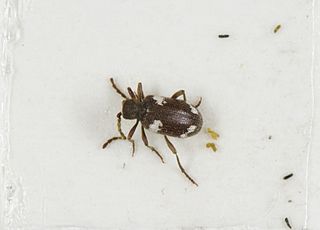
Claudius Rey (2 September 1817, in Lille – 31 January 1895, in Lille) was a French entomologist .

Lille is a city at the northern tip of France, in French Flanders. On the Deûle River, near France's border with Belgium, it is the capital of the Hauts-de-France region, the prefecture of the Nord department, and the main city of the European Metropolis of Lille.

France, officially the French Republic, is a country whose territory consists of metropolitan France in Western Europe and several overseas regions and territories. The metropolitan area of France extends from the Mediterranean Sea to the English Channel and the North Sea, and from the Rhine to the Atlantic Ocean. It is bordered by Belgium, Luxembourg and Germany to the northeast, Switzerland and Italy to the east, and Andorra and Spain to the south. The overseas territories include French Guiana in South America and several islands in the Atlantic, Pacific and Indian oceans. The country's 18 integral regions span a combined area of 643,801 square kilometres (248,573 sq mi) and a total population of 67.3 million. France, a sovereign state, is a unitary semi-presidential republic with its capital in Paris, the country's largest city and main cultural and commercial centre. Other major urban areas include Lyon, Marseille, Toulouse, Bordeaux, Lille and Nice.
Rey’s family owned a prosperous printing works which went bankrupt in 1847. One of his uncles, the owner of a vineyard producing Morgon, offered him employment. Impassioned by entomology, he began a collaboration with Etienne Mulsant (1797–1880) who was then working on Histoire naturelle des coléoptères de France - Natural History of the Beetles of France. In 1852, Rey settled in Lyon, in the residence of his brother in Saint-Genis-Laval. He took his Winter holidays in the South of France seeking insects. His work with Mulsant lasted until Mulsant’s death. The majority of the texts on Staphylinidae are the work of the two entomologists but five parts (Habrocerinae, Tachyporinae, Trichophyinae, Picropeplinae and Steninae) are the work of Rey alone. The Coleoptera are not the only study of Mulsant and Rey since they also worked on naturelle des punaises de France -the Natural history of the True Bugs of France. In addition to these publications, Claudius Rey wrote many articles on Coleoptera in journals . He described 8 genera and 48 species. 116 genera and 407 species bear his name alongside that of Mulsant.

Printing is a process for reproducing text and images using a master form or template. The earliest non-paper products involving printing include cylinder seals and objects such as the Cyrus Cylinder and the Cylinders of Nabonidus. The earliest known form of printing as applied to paper was woodblock printing, which appeared in China before 220 AD. Later developments in printing technology include the movable type invented by Bi Sheng around 1040 AD and the printing press invented by Johannes Gutenberg in the 15th century. The technology of printing played a key role in the development of the Renaissance and the scientific revolution, and laid the material basis for the modern knowledge-based economy and the spread of learning to the masses.

A vineyard is a plantation of grape-bearing vines, grown mainly for winemaking, but also raisins, table grapes and non-alcoholic grape juice. The science, practice and study of vineyard production is known as viticulture.

Lyon is the third-largest city and second-largest urban area of France. It is located in the country's east-central part at the confluence of the rivers Rhône and Saône, about 470 km (292 mi) south from Paris, 320 km (199 mi) north from Marseille and 56 km (35 mi) northeast from Saint-Étienne. Inhabitants of the city are called Lyonnais.













